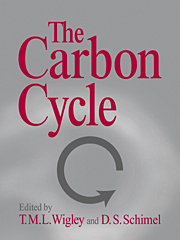Book contents
- Frontmatter
- Contents
- Preface
- Acknowledgments
- Contributors to the 1993 Global Change Institute
- I INTRODUCTION
- II THE MISSING CARBON SINK
- 3 Carbon Dioxide Emissions from Fossil Fuel Consumption and Cement Manufacture, 1751–1991, and an Estimate of Their Isotopic Composition and Latitudinal Distribution
- 4 Emissions of Carbon from Land-Use Change
- 5 The CO2 Fertilizing Effect: Relevance to the Global Carbon Cycle
- 6 Soils and the Global Carbon Cycle
- 7 Grasslands and the Global Carbon Cycle: Modeling the Effects of Climate Change
- 8 Constraints on the Atmospheric Carbon Budget from Spatial Distributions of CO2
- 9 Estimating Air–Sea Exchanges of CO2 from pCO2 Gradients: Assessment of Uncertainties
- 10 Atmospheric Oxygen Measurements and the Carbon Cycle
- 11 A Strategy for Estimating the Potential Soil Carbon Storage Due to CO2 Fertilization
- III PALEO-CO2 VARIATIONS
- IV MODELING CO2 CHANGES
- Part V Appendixes
- Index
6 - Soils and the Global Carbon Cycle
from II - THE MISSING CARBON SINK
Published online by Cambridge University Press: 04 December 2009
- Frontmatter
- Contents
- Preface
- Acknowledgments
- Contributors to the 1993 Global Change Institute
- I INTRODUCTION
- II THE MISSING CARBON SINK
- 3 Carbon Dioxide Emissions from Fossil Fuel Consumption and Cement Manufacture, 1751–1991, and an Estimate of Their Isotopic Composition and Latitudinal Distribution
- 4 Emissions of Carbon from Land-Use Change
- 5 The CO2 Fertilizing Effect: Relevance to the Global Carbon Cycle
- 6 Soils and the Global Carbon Cycle
- 7 Grasslands and the Global Carbon Cycle: Modeling the Effects of Climate Change
- 8 Constraints on the Atmospheric Carbon Budget from Spatial Distributions of CO2
- 9 Estimating Air–Sea Exchanges of CO2 from pCO2 Gradients: Assessment of Uncertainties
- 10 Atmospheric Oxygen Measurements and the Carbon Cycle
- 11 A Strategy for Estimating the Potential Soil Carbon Storage Due to CO2 Fertilization
- III PALEO-CO2 VARIATIONS
- IV MODELING CO2 CHANGES
- Part V Appendixes
- Index
Summary
Abstract
Soils hold one of the largest near-surface pools in the global carbon cycle, containing at least 1,500 Pg C in organic forms, with a large proportion of this amount lying near the surface. Largely as a result of the human disturbance of soils, especially in cultivation, 36 Pg C was lost from soils between 1860 and 1960, with a current rate of loss of approximately 0.8 Pg C/yr. Thus, the loss of carbon from soils is a significant component of the biotic flux of CO2 to the atmosphere The soil carbon pool does not appear likely to house the missing sink. In fact, as a result of global warming, substantial amounts of CO2 are likely to be lost from soils.
Introduction
Soils hold one of the largest near-surface pools in the global carbon cycle, containing at least 1,500 Pg C in organic forms. Although some fractions of soil organic matter are very old, the global mean residence time for organic carbon in soils is approximately 30 years. The soil carbon pool is large and dynamic; increases or decreases in the amount of carbon in soils could have significant effects on the concentration of CO2 in the atmosphere (Trumbore et al., 1996). A large literature shows that human activities – especially cultivation – reduce the pool of carbon in soils and that most of this carbon is transferred to the atmosphere.
- Type
- Chapter
- Information
- The Carbon Cycle , pp. 93 - 101Publisher: Cambridge University PressPrint publication year: 2000
- 12
- Cited by



